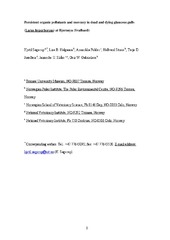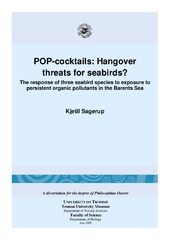| dc.description.abstract | The overall aim of the thesis was to study immunological effects of pollutants in Barents Sea. The Glaucous gull (Larus hyperboreus), black-legged kittiwake (Rissa tridactyla) and Atlantic puffin (Fratercula arctica) were studied. The apex predatory glaucous gull have high levels of persistent organic pollutants (POPs), while the fish eating black-legged kittiwake and Atlantic puffin are located lower in the food-chain and have lower levels of POPs.
In breeding glaucous gulls, positive correlations between levels of intestinal nematode and organochlorine (OC) levels were observed. The intestinal parasite intensities could be seen as an end result of the immune system’s battle against the establishment and survival of the parasites. An increased infection with increased OC levels might be explained by immune suppression activity of OCs.
The influence of the Barents Sea’s POP-cocktails on the developing immune system was studied on laboratory-raised glaucous gull chicks. The polluted group that simulated “naturally” polluted glaucous gull chicks responded less well to an influenza vaccine and had lower levels of circulating immunoglobulin-G (IgG) and IgM than the control group.
The hypothesis of a POP-induced immune suppression was also investigated in the less polluted black-legged kittiwake and Atlantic puffin. The predictions of an altered level of circulating IgG with OCP, PCB or PBDE levels were tested. The results show no indication of correlations between the IgG and pollutant levels.
Naturally dead glaucous gulls were studied in an attempt to evaluate whether pollutants contribute to the death. Autopsies and POP analyses reveal that the brain levels of pesticides and PCBs were the same as in a sample of dead glaucous gulls from 1989, while the liver levels were significantly lower. The brain levels thereby strengthen the theory that an additional stress provided from elevated pollutant levels could be deadly. | en |
| dc.description | Papers number 1,2 and 3 of the thesis are not available in Munin due to publishers' restrictions. Paper 4 is a manuscript, and not available in Munin.<br> 1. Sagerup, K., Henriksen, E.O., Skorping, A. Skaare, J.U., Gabrielsen G.W.: "Intensity of parasitic nematodes is associated with organochlorine levels in the
glaucous gull (Larus hyperboreus)." Jornal of Applied Ecology 2000; 37: 532-239 (British Ecology Society). Available at <a href=http://dx.doi.org/10.1046/j.1365-2664.2000.00521.x>http://dx.doi.org/10.1046/j.1365-2664.2000.00521.x</a><br>2. Sagerup, K., Larsen, H.J.S., Skaare, J.U., Johansen, G.M., Gabrielsen, G.W.: "The toxic effects of multiple persistent organic pollutant exposures on the post-hatch
immunity maturation of glaucous gulls." Journal of Toxicology and Environmental Health - Part A 2009; 72: 1-14 (Taylor & Francis). Available at <a href=http://dx.doi.org/10.1080/15287390902959516>http://dx.doi.org/10.1080/15287390902959516</a><br>3. Sagerup, K., Savinov, V., Savinova, T., Kuklin, V.V., Muir, D.C.G., Gabrielsen, G.W.: "Persistent organic pollutants, heavy metals and parasites in the glaucous gull (Larus hyperboreus) on Spitsbergen." Environmental Pollution 2009; 157(8-9): 2282-2290 (Elsevier). Available at <a href=http://dx.doi.org/10.1016/j.envpol.2009.03.031>http://dx.doi.org/10.1016/j.envpol.2009.03.031</a><br>4. Sagerup, K., Åsbakk, K., Polder A., Skaare, J.U., Gabrielsen, G.W., Barrett, R.T.: "The effect of persistent organic pollutants (POPs) on the immune system of black-legged kittiwakes and Atlantic puffins in the Barents Sea." Manuscript. | en |


 English
English norsk
norsk
